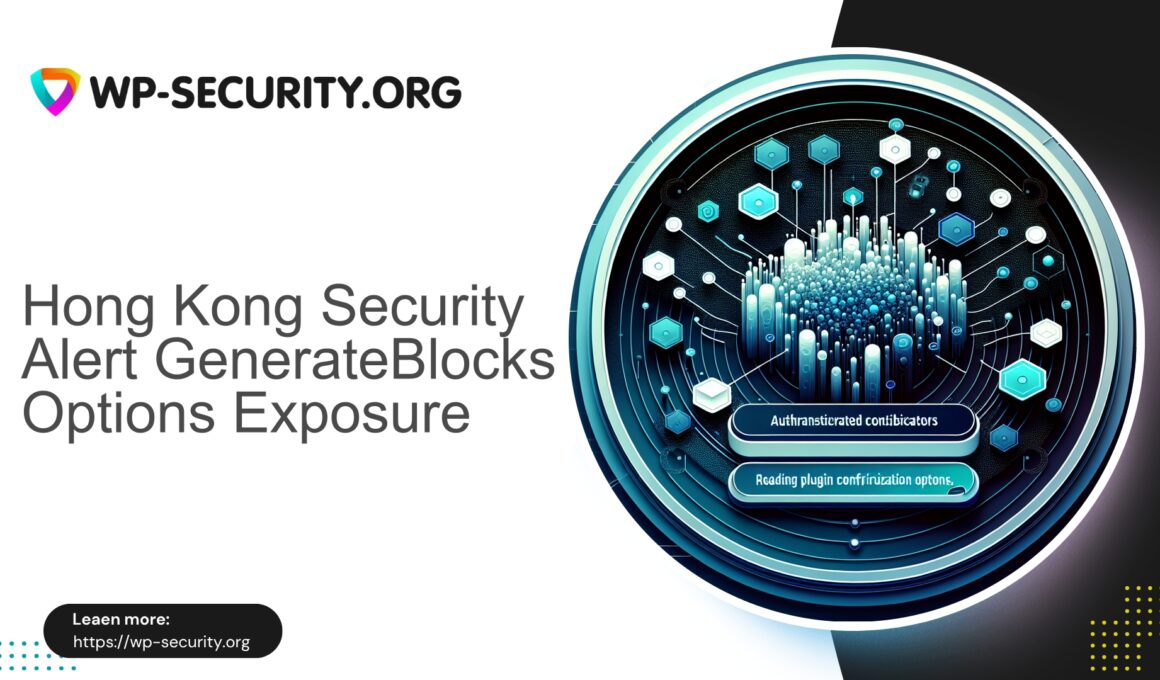| Plugin Name | GenerateBlocks |
|---|---|
| Type of Vulnerability | Broken access control |
| CVE Number | CVE-2025-11879 |
| Urgency | Low |
| CVE Publish Date | 2025-10-25 |
| Source URL | CVE-2025-11879 |
GenerateBlocks — CVE-2025-11879: Broken access control (Hong Kong security expert analysis)
Summary: GenerateBlocks has an identified broken access control issue catalogued as CVE-2025-11879 (published 2025-10-25). The vendor classified the urgency as Low. Broken access control can allow unprivileged or incorrectly authorized actors to perform actions they should not be allowed to perform. Below I provide a focused technical analysis and practical mitigation steps suited to Hong Kong businesses and technical teams.
What the issue means
Broken access control usually indicates that an endpoint, API, or administrative functionality is not enforcing capability checks correctly. In a WordPress context this can lead to low-privilege users (for example, contributors or authors) being able to modify blocks, templates, settings or other content that should be restricted to administrators.
Potential impact
- Unauthorized content or template changes (site content integrity issues).
- Privilege escalation pathways if attackers can manipulate capabilities or create administrator accounts.
- Reputational risk and possible regulatory exposure for businesses handling user data in Hong Kong (PDPO considerations).
- Supply chain risk where compromised content or templates are used across multiple pages or sites.
Exploitability and risk context
- The CVE is rated Low, which typically indicates either additional conditions are required for exploitation (for example, an authenticated lower-privilege user) or the scope of impact is limited.
- Risk increases on multi-author sites, sites that allow open registrations, or where contributor/editor roles are granted to third parties or contractors.
- Even low-severity access control issues should be treated seriously on business-critical sites because of lateral movement and content injection risks.
Indicators of compromise (what to look for)
- Unexpected changes to block templates, global styles, or reusable blocks.
- New or modified pages and posts from accounts that normally do not perform such changes.
- Suspicious HTTP requests to plugin-related endpoints (check access logs for unusual POST/PUT requests).
- Unusual user creation events or elevation of privileges in the users table.
- Database rows changed in options or postmeta related to GenerateBlocks-managed data.
Immediate mitigations (short-term)
- Check whether a patched version is available from the plugin author and plan an update during a maintenance window.
- If a patch is not yet available, consider temporarily deactivating the plugin on critical systems until a fix is applied.
- Restrict administrative access: review and remove unnecessary admin/editor accounts; reduce the number of people with elevated privileges.
- Limit access to wp-admin and related endpoints by IP (where feasible) or enforce VPN access for administrators.
- Enable strong authentication for all accounts with publishing or administrative rights (complex passwords and 2FA).
- Take a backup prior to any remediation step so you can restore quickly if needed.
Recommended technical mitigations (medium-term)
- Apply the official patch from the plugin author as soon as it is released and test in staging first.
- Harden REST API and AJAX endpoints by validating capability checks and limiting callable actions to trusted roles. Example snippet to block REST API for unauthenticated requests or require a capability:
add_filter('rest_authentication_errors', function($result) { if (!empty($result)) { return $result; } if (!is_user_logged_in() || !current_user_can('edit_posts')) { return new WP_Error('rest_forbidden', 'REST API access restricted.', array('status' => 403)); } return $result; });Note: adapt capability checks to your environment and test thoroughly.
- Enforce principle of least privilege for roles; where possible use custom roles with precise capabilities rather than broad roles.
- Harden file permissions and ensure plugin files are not writable by the web server where not necessary.
- Implement monitoring and alerting for changes to key tables (posts, postmeta, options, users) and for administrative actions.
Operational guidance for Hong Kong organisations
- Document any incident handling and remediation steps to meet internal audit and, where applicable, PDPO record-keeping requirements.
- Communicate risks to stakeholders—content integrity issues can affect brand trust and customer confidence.
- Coordinate with development teams to ensure that staging and CI/CD pipelines validate plugin updates before production rollout.
Post-remediation checks
- Confirm the plugin version is updated and verify changelog entries that address access control fixes.
- Audit user accounts and capability grants to ensure no unauthorized privilege escalation occurred.
- Review web server and application logs for suspicious activity during the vulnerable window.
- Restore from a verified clean backup if evidence of compromise is found and complete a thorough forensic review.
Where to get authoritative information
Refer to the official CVE record and the GenerateBlocks plugin page for vendor advisories and patched releases. The CVE entry is linked in the summary table above. Always prioritise official patches from the plugin author and validate updates in a controlled environment first.
Conclusion
CVE-2025-11879 is classified as a low-urgency broken access control vulnerability, but it presents a meaningful risk in environments with multiple content contributors or lax privilege management. The practical approach for Hong Kong enterprises is clear: apply vendor patches promptly, minimise privileged accounts, harden access to administrative endpoints, and maintain robust logging and backups. Quick, measured action reduces both technical and regulatory exposure.
Author: Hong Kong security practitioner — pragmatic analysis for site owners and IT teams. This post is intended to inform technical remediation and operational decisions; it does not replace formal incident response or legal advice.
